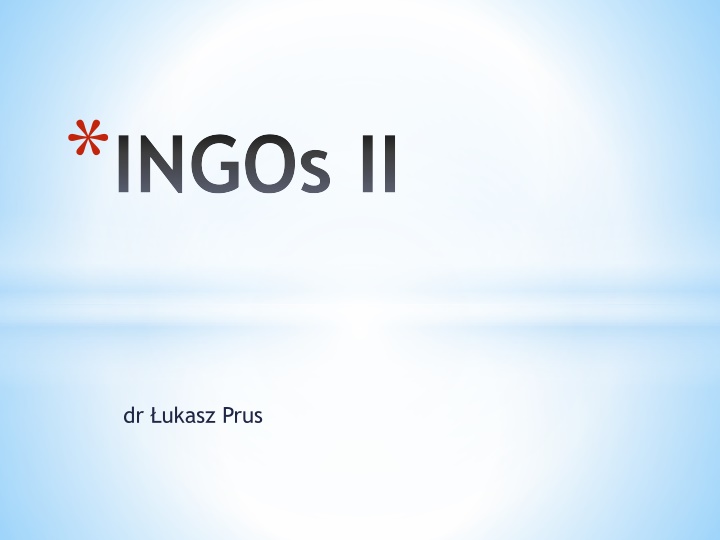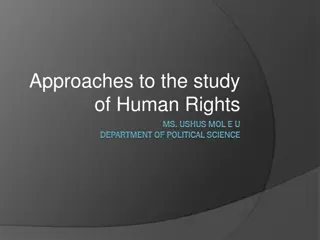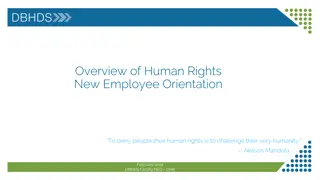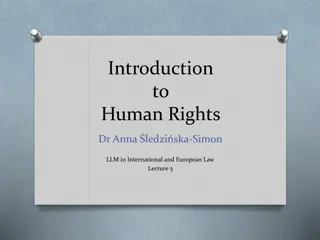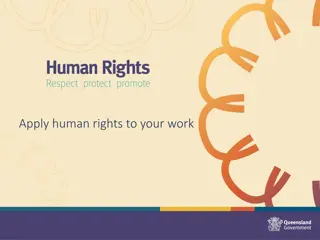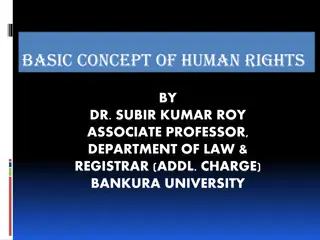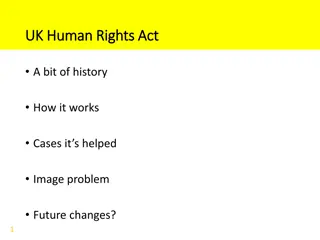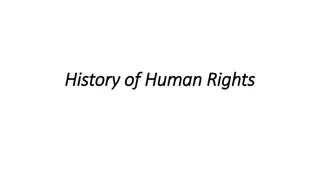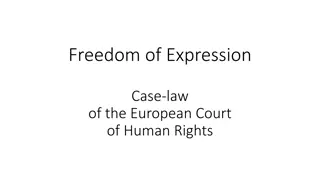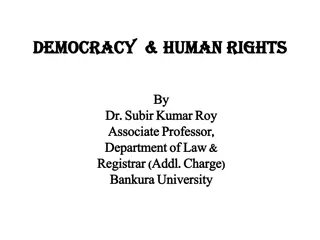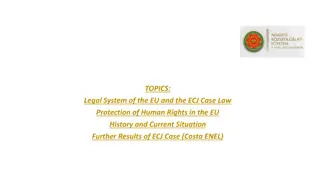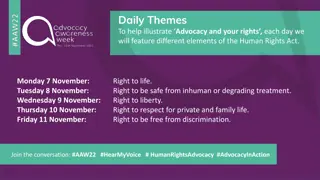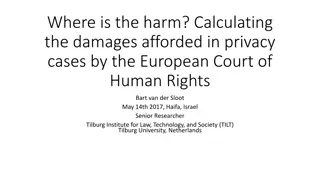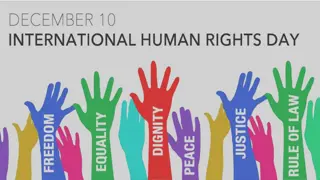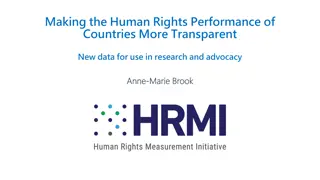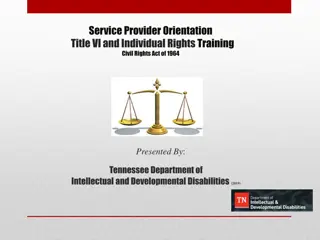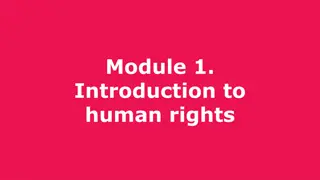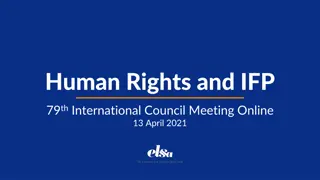HRINGOs and Their Role in Promoting Human Rights
HRINGOs, or Human Rights International Non-Governmental Organizations, play a crucial role in promoting and protecting human rights globally. These organizations are independent of political groups and work tirelessly to ensure governments uphold human rights principles. Through monitoring actions, applying pressure, and advocating for change, HRINGOs contribute significantly to advancing human rights norms and defending individuals' rights. Examples of HRINGOs include Amnesty International, Human Rights Watch, and more, all dedicated to safeguarding human rights and combating abuses.
Download Presentation

Please find below an Image/Link to download the presentation.
The content on the website is provided AS IS for your information and personal use only. It may not be sold, licensed, or shared on other websites without obtaining consent from the author.If you encounter any issues during the download, it is possible that the publisher has removed the file from their server.
You are allowed to download the files provided on this website for personal or commercial use, subject to the condition that they are used lawfully. All files are the property of their respective owners.
The content on the website is provided AS IS for your information and personal use only. It may not be sold, licensed, or shared on other websites without obtaining consent from the author.
E N D
Presentation Transcript
*INGOs II dr ukasz Prus
*HR INGOs *HUMAN RIGHTS INTER NON- GOVERNMENTAL ORGANIZATIONS 2
*HR INGOs have led the promotion and universalization of human rights norms, *even though the formal creation and promotion of human rights law is carried out by states *acting in concert and separately within and outside the ambit of the UN. 3
*Definition of HRINGOs *A private international association *which devotes (spends) significant resources to the promotion and protection of HR, *Which is independent of both governmental and political groups that seek political power, and does not itself seek such power * L. Wiseberg, Protecting Human Rights Activists and NGOs: What more can be done?, Human Rights Quarterly 1991, No 13 4
*This definition is meant to distinguish HR INGOs from political parties, *government-sponsored or political party-based organizations *and politically-organized, *respectively, that only use HR rhetoric for partisan ends.
*Many organizations around the world *dedicate their efforts to protecting human rights and ending human rights abuses. *HR INGOs monitor the actions of governments and *pressure them to act according to human rights principles
*Examples of HRINGOs *Amnesty International *Human Rights Watch *International Commission of Jurists (ICJ) *Lawyers Committee for Human Rights, *Article 19 (this organization takes its name from Article 19 of the Universal Declaration of Human Rights, which says, that everyone has the right to freedom of opinion and expression ( ) ) *Interrights
*European Human Rights Advocacy Center *Fair Trials International *Mental Disability Advocacy Center *Reporters without Borders *Open Society Justice Initiative 8
*Human Rights Action Center *Simon Wiesenthal Center 9
*The International League for the Rights of Man *Now the International League for Human Rights *Is the oldest such organization, founded in New York in 1942 10
*At various times it has focused on *victims of torture *Religious intolerance *Roger Baldwin the founded the The International League for the Rights of Man *He also founded the American Civil Liberties Union civil rights organization 11
*the International League for Human Rights itself was responsible for establishing in New York the Lawyers Committee for Intentional HR, *now known as the Lawyers Committee for Human Rights *Another of the more important INGOs, in 1975 *the Lawyers Committee for Human Rights claims promote the HR standards contained in the International Bill of Rights 13
*The New York-based Human Rights Watch *Human Rights Watch was founded by Robert L. Bernstein *as a private American INGO in 1978, *under the name Helsinki Watch, to monitor the Soviet Union 14
*HRW has developed into the most dominant American INGOs working to expose violations of basic liberal freedoms *HRW publish reports on HR abuses US or other countries 16
*Two other leading HR INGOs are located in Europe *In the UK and Switzerland *The Geneva-based International Commission of Jurists (ICJ) *was founded in 1952 to promote the rule of law throughout the world 18
*The ICJ has been accused of being a tool of the West in the Cold War, *Spending considerable resources exposing the failures of Soviet bloc. *The ICJ was initially funded by the Central Intelligence Agency. *The ICJ was established following the 1952 International Congress of Jurists in West Berlin. 20
*The Congress was organized by the Investigating Committee of Free Jurists (ICJF) , *a group of German jurists committed to investigating human rights abuses carried out in the Soviet Zone of post-war Germany *One of the founders Dr. Walter Linse was arrested by East German intelligence agents and delivered to the KGB. *Today it is regarded as a bona fide INGOs, concerning with rule of law questions in the South 21
*Last but not least *The London-based Amnesty- International (AI), *The most powerful HR INGOs *Is today synonymous with the HR movement and has inspired the creation of many similar HR groups around the world 22
*It was lunched by Peter Benenson, a British lawyer, writing in the May 1961 issues of the Observer and Le Monde * Forgotten Prisoners *The recipient of the 1977 Nobel Peace Prize, AI claim that its object is to contribute to the observance HR *Through campaigns to free prisoners of conscience 23
*To ensure fair trails within reasonable like for political prisoners, *To abolish death penalty *Torture *And other cruel treatment of prisoners 24
*Prisoner of conscience is a term coined by Peter Benenson in a 28 May 1961 article ("The Forgotten Prisoners") for Observer *This term can refer to anyone imprisoned because of their race, sexual orientation, religion, or political views. *It also refers to those who have been imprisoned and/or persecuted for the non-violent expression of their held beliefs 27
*HR INGOs methods Why HR INGOs may have impact: they do not make political decisions INGOs are responsible before the society and their sponsors INGOs are transmitter of views of the society and minority to the government Most important features of INGOs dealing with human rights Credibility Public trust and confidence Responsiveness Independence Dynamism 29
Depending on mission and scope of operation HR INGOs use different methods in order to protect human rights. Traditionally and basic methods Investigation Monitoring Advocacy Strategic litigation Education 30
*Investigation usually takes place in a Third World country, *while monitoring (reporting) and advocacy aim at reforming policies of industrial democracies and intergovernmental agencies to trigger bilateral and multilateral action against the repressive state. 31
*Some HR INGOs now go beyond this denunciatory framework * and work to foster and strengthen processes and institutions *rule of law, and constitutions, judiciaries, legislatures, and electoral machineries that ensure the protection of civil and political rights. 32
*Although the ideological commitment of these INGOs seems clear through their mandates and work, they nevertheless cast themselves as nonideological *For example, AI refused to condemn apartheid as a political system or to adopt Nelson Mandela, the century s most prominent prisoner, as a prisoner of conscience 33
*HR INGOs role of watchdog *controlling the government and other institutions (also private institutions) *Watchdog organizations are non-profit groups that view their role as critically monitoring the activities of governments or other organiztions *and alerting the public when they *detect actions that go against the public interest 35
*Monitoring: *Day to day monitoring (e.g. freedom of speech) *Controlling compliance with certain standards (e.g. controlling prisons in certain area) *Preparation of reports on compliance with human rights on the basis of monitoring *Results: *reports, *interventions, *raising awareness, *accountability *Examples: HRW report on violations of human rights in Russian-Georgian conflict 36
*Purposes of monitoring *to help people (monitoring + intervention) *to have independent data and be a source for media *to compel (enforce) the government to change the law or practice *to show violations to international community (e.g. cluster ammunition in conflict in Georgia) *or prepare reports to international bodies (e.g. EU, UN, Council of Europe) 37
*Barriers to monitoring *Sometimes need of cooperation with government (e.g. controlling prisons) *Serious monitoring requires human resources, time and money *You cannot expect results immediately it is rather long-term investment *Monitoring in conflict zones may be risky *Sometimes HR INGOs may need a special status at a certain international organization, e.g. consultative status at the Council of Europe 38
*Advocacy means arguing on behalf of a certain issue, idea or person *Changing the attitude of government *Showing the problem *Convincing the society *Advocacy means fighting for something, but without an intent to be elected for public position 39
*Example of advocacy *Cluster Munition Coalition *is an international coalition working and campaigning against the use and production, *Cluster munitions are a type of explosive weapon *Methods: *Signing letters and petitions *Building international coalitions *Informing the public opinion on the problem 40
*Convincing famous persons to support activities *Public events and protests *Organization of conferences and other events *Engaging people into actions 41
*advocacy typical topics *Abolishing death penalty *Release of political prisoners *Counteracting HIV/AIDS *Abuse of human rights by corporations *Anti-terrorism legislation and human rights *Domestic violence 44
*Strategic litigation (strategic judicial cases) means trying to secure legal judgments that *cases have an enormous impact outside the courtroom (e.g. by dismantle an entrenched system that affects many people). *The objective of strategic litigation is to make significant changes in law or legal practice through litigation (court/judicial conflict) 45
*Aim of strategic litigation *effect of scale - with one case you may resolve the whole problem *different additional functions (raising awareness, education on rights, involvement of civil society) *it does not replace legislative reforms but may speed them up *elimination of unjust gaps (loopholes) in the legal system *best education for human rights lawyer 46
*Steps in strategic litigation *Selection of a case *Identification of a problem *Representation of victim in court *Informing the public opinion on the character of the case Monitoring of an enforcement of judgment by the government 47
*Methods *Representation of victims *Standing for HRNGOs as amicus curiae (friend of the court) someone who is not a who is not a party, but who assists a court by offering information that bears on the case. *Possibility to submit third-paty intervention *Unlawful detention complaints and others complaints *Action for damages 48
*Famous strategic litigation *- Brown v. Board of Education of Topeka (segregation in schools) *-D.H. and others v. Czech Republic (discrimination of Roma children in schools) *B czkowski and others v. Poland (ban of assembly organized by minority groups) *Nachova and others v. Bulgaria (burden of proof in racially motivated killings) 49
